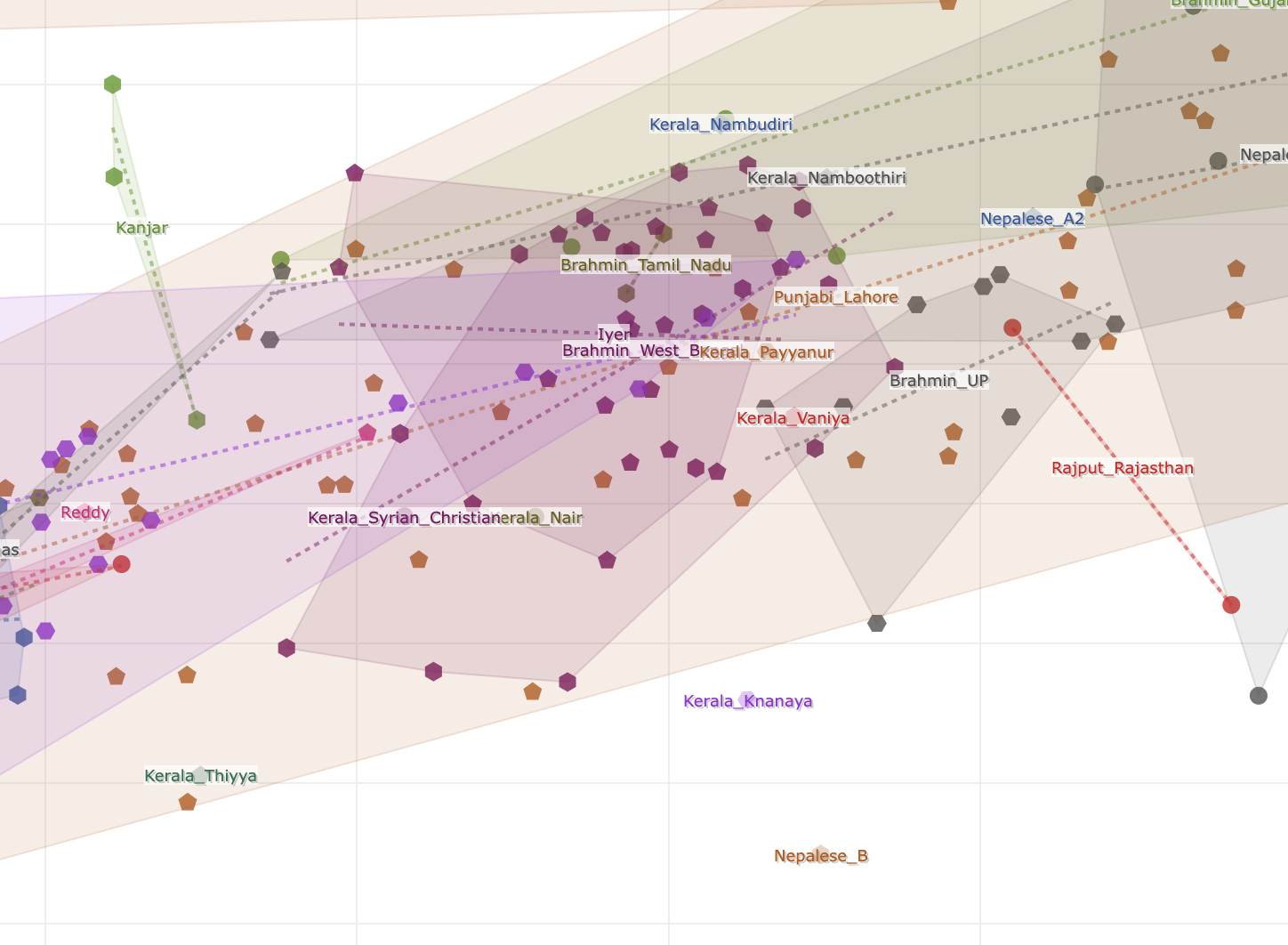Below is a custom-PCA that shows us the genetic variation in modern Indo-Iranians.
As we head to the right, we see South Indian OBCs and farming castes, as well as some North Indian Chamars, Punjabi Christians, Marathas and Yadavas clustering together. These groups have little Steppe ancestry and are mostly a 50:50 mix of Iranian Farmer:AASI. It is interesting to see Christians from Punjab cluster with South Indian OBCs and Chamars, this would make sense since they might be converts from the lower castes. A note must be made here: it's unlikely the Yadavs here are from North India, as the ones from North India have 15-20% Steppe ancestry, rather they maybe Gollas from the Telugu states.
The Marathas in the G25 dataset are from Karnataka so only have 5% Steppe ancestry. It's quite possible that 96 Kulin Maratha have a different genetic profile. Moving further to the right, we see some Reddys, Velamas and a lot of Punjabi Lahore samples. Now, the Reddys are a dominant land-owning caste of the Telugu-speaking lands and while traditionally considered as Shudra, they were warriors who ruled a kingdom.
In fact, for any non-Indian reading this post, it must be ascertained that Shudra did not really represent a "low-caste" historically, but only the caste of farmers and pastoralists, who occassionally would also become warriors. The original Vaishya caste had this function in Vedic times: that of pastoralists and farmers, hence why they were literally called the vish, or the people. This function got transfered to the Shudras long before Christ was born, which is why the Manusmriti talks about Shudra Kings ruling in different parts of India.
Moving on, what's interesting is the diversity in the Punjabi_Lahore cluster. A lot of the people in it cluster with South Indians, and a lot are on the other extreme, clustering with Punjabis Jats, Kamboj and Khatris. This tells us that the researchers who sampled this did not take caste into account, so Lahori Punjabis from Pakistan who are low caste got included in a label with Lahori Punjabis from Pakistan who are Jats, Gujjars etc.
Further right, we see a cluster that has most Brahmins, a few Keralites, many Nepalese and a couple of Rajputs. This is the generic "UC" or Upper Caste cluster. By the way, ignore the Uttar Pradesh Brahmin outliers and Rajput outliers from this PCA. They are shifted towards Mongoloid Tibeto-Burmans, and this maybe because they're from Uttarakhand where the natives are mixed with Tibeto-Burmans, or it maybe a case of mislabelling the samples. The non-outlier Rajput from Rajasthan clusters with UP Brahmins. Regardless, we see that Bengali Brahmins, Tamil Brahmins, Keralite Brahmins, Rajputs, some Keralite middle castes such as Vaniya and Christian and many Nepali Brahmins cluster together. Many samples from Punjabi_Lahore can also be found here.
Further right, we see the North-West Brahmin cluster, which is more Steppe/West Eurasian shifted than the generic UC cluster, and has Brahmins from Jammu, Himachal, Kashmir and Gujarat, clustering along with some Punjabi Hindus and NepaleseA (likely Nepali Brahmins).
To the right of this, we get the North West Indo-Pakistani cluster, which contains the most Steppe and Eurasian shifted groups in the subcontinent. Notice how the Rors and Kalash lie a little distinct from this cluster too. The Kalash do not have that much Steppe ancestry (25%) but they do have a lot of Siberian/Turanian ancestry from Bronze Age groups such as Aigryzhal_BA, and actually the Kalash are shifted towards them on the PCA. This becomes more clear when we see a 3D PCA (the one posted here is 2D unfortunately).
The main North-West subcontinental tribes such as Sindhis, Khatris, Jatt Sikhs, Jat Hindus, Kamboj and Pakistani Pashtuns cluster together. We can notice how most of the Jat_Hindus cluster have an overlapping cluster with the Rors, indicating many have similar ancestry; however, one of the Hindu Jats is an outlier and clusters with the less Steppe, more AASI shifted Northern Upper castes. This might indicate variation in Jat Hindus, but we might just have too little samples.
Yusufzai and Uthmankhel are Pashtuns from Pakistan, who are shifted to the Iranic cluster but still visibly in range of the NW Indo-Aryan one, thus indicating they have overlapping ancestry from both groups. Also, one can see me in this cluster too, plotted next to the Khatri:K56 sample. This is typical of my own ancestry as a NW Indo-Aryan (55:30:10:5, Indus:Steppe:AASI:BMAC).
Now begins the Iranic side of Indo-Iranian, the other branch. First, we come to the Eastern Iranic cluster. The Baloch are split up in 2, with BalochB must more Indo-Aryan shifted while BalochA cluster with the Brahui and one lone southward shifted Tajik. Notice the Brahui, a Dravidian speaking group from Pakistan that has ancestry very typical of Balochi Iranic speakers, perhaps a relic population from the Indus Valley?
Tajiks are notably northern shifted, as they carry the highest Steppe MLBA ancestry in South-Central Asia, followed closely by Hindu Jats and Rors. Yaghnobi Tajiks, who still speak an Eastern Iranic tongue, have almost no AASI ancestry and hence are visibly separated from the rest. Tajiks from Hisor and Ayni generally have the highest East Asian ancestry in Tajikistan (upto 15%) and the lowest Steppe MLBA (30%).
Finally, we come to the Western Iranian cluster, that contains Parsis, Lors, Zoroastrians, Persians and Kurds. Note how Parsis from Pakistan and India cluster with Western Iranians, this makes sense as they are 75% West Iranian, 25% Indo-Aryan in DNA. One will also notice how Iranians from Bandari are the closest to Parsis, this also makes sense as they have the highest Indian ancestry in Iran. Bandari in Iranian literally means "from a port" and these are Iranians from the Gulf who obviously had trade contacts with India and Africa (which is also why they carry around 3% Bantu ancestry). By the way, Bandar in Hindi would be 'Bandhdvar', so one can now see the etymology clearly, meaning 'closed door'











No comments:
Post a Comment